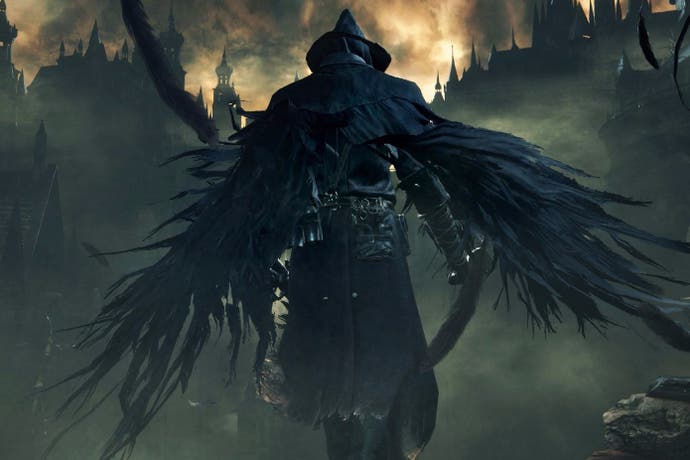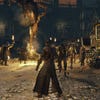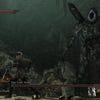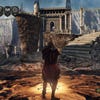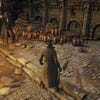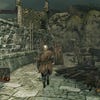Is Bloodborne the next-gen Souls you've been waiting for?
And where does that leave the Dark Souls 2 remaster?
Despite its frame-pacing issues and long load times, Bloodborne is still very much worth the rush of commotion it's receiving this week. The game sits high in the hierarchy of quality PS4 exclusives, its only real competition in the gameplay stakes coming via From Software's very own remaster of Dark Souls 2, due out next week. With a new enemy layout, improved lighting and 1080p60 gameplay, the remaster's bid for relevancy is strong, but does Scholar of the First Sin keep up on technical grounds, or does Sony's exclusive steal the show?
Similar to Dark Souls 2, Bloodborne lives up to its resolution promise. A close pixel count shows a true, native 1920x1080 title at work, and save for the pixel crawl on the game's fences and fur shaders, the results are often impressive. However, a heavy chromatic aberration effect is applied to Bloodborne: mimicking the qualities of a low quality lens, the effect applies a distortion to anything from the embers of a bonfire to the chrome flash on a wagon-wheel, and splits light into its constituent colours.
It's fair to say this post-process trick won't be to everyone's tastes. Reportedly using Silicon Studio's Yebis 3 optical effects suite (also seen in Final Fantasy 15) the sheer strength of this filter can distract. At range, it heavily blurs the edges of the screen, and also exaggerates any pixel-crawl evident across tight-knit cobblestones and fences. This side-effect is the game's only real visual shortcoming, as the rest of the game - between the dynamic lighting and the sharp texture-work of Yharnam's streets - looks exceptional.
Yharnam's intricate detailing more than makes up for this. Unlike Dark Souls 2's early Heide's Tower of Flame section, which layers its stone pathways with high resolution but ultimately flat-looking normal maps, Bloodborne is far more ambitious. Each segment of its world benefits from what appears to be tessellation (or costly parallax occlusion mapping), which in conjunction with a displacement map gives the city's rickety brick roads unique juts and divots. For the Hunter's Dream hub, each stone slab surrounding its enclave pops outward in a 3D fashion, giving everything a very organic look.
The results are fantastic, and with strong anisotropic filtering in tow, it places Bloodborne's world among the most detailed seen from the studio. Dark Souls 2 doesn't go entirely without though; its textures are pinpoint-sharp in the PS4 remaster thanks to the use of PC-grade assets, while a new high-dynamic range filter increases their contrast. Instances of tessellation are also spotted in specific spots around Heide's Tower, though Bloodborne uses this trick to an extreme that Dark Souls 2 doesn't match.
Bloodborne's enemy models take a leap in quality too. Even the most basic townsfolk feature fur shaders, an evident boost in polygon count, plus cloth physics. Dark Souls 2's minion designs are basic by contrast, tending towards armour-clad knights that keep its RAM footprint low, better suiting its cross-gen status. In an interview with From Software staff, programmer Jun Ito says, "up until now we've worked in worlds that feature a lot of armour." However, he goes on to describes how PS4 unlocked new options for Bloodborne, where the team "spent a lot of CPU power, [especially] on simulating fabric."
Indeed, Havok physics play a big part in making From Software's worlds and characters more tangible. A player's cloak-tails now dynamically whip around to each step, and even its front buckles individually sway to motion. Yharnam's every corner is replete with destructible urns and crates too, giving an otherwise rigid town layout a dense, lived-in appearance.
Best of all, full ragdoll physics are in place for all enemies in Bloodborne. This means slain ogres can tangle round a player's ankles while running past, often creating humorous moments where a bodies roll haphazardly behind. It's a playful aside to the experience that director Hidetaka Miyazaki clearly intends for his games, and hence its physics are similar to those in Demon's Souls and the first Dark Souls. Its removal in Dark Souls 2 - a game produced with Miyazaki in only a supervisor position - instead has larger enemies fizzling out of view on death, or simply laying static on the ground.
Both PS4 games feature ambient occlusion too, and in each case the result is more nuanced than the dithered approach used on last-gen Dark Souls 2. This shades in areas beneath grass tufts, and in Bloodborne's case, behind the overhanging plants the Hunter's Dream - though its chromatic aberration makes this harder to catch by eye. The PS4 exclusive also boasts much improved specular mapping, giving floors a dripping wet, dewy effect, as also shown on a player's blood-soaked cloak after battle.
The low dusk sun in Central Yharnam draws out other interesting details. Curiously, we see player shadows falling at an odd angle relative to the sun's position (notably near its main lamp). It's thankfully not an issue later on, but it makes clear that dynamic shadows aren't Bloodborne's strong suit, with bonfires leaving no shadow at all. It's unlike Dark Souls 2, where shadows are produced by any torch or flame. A point in favour of the older game is unexpected, especially as this feature hangs over from an earlier build (as seen at E3) where interplay with lighting was a greater focus.
On balance, Bloodborne is a far more accomplished game on the visual front. Its geometry, effects, and even its lighting model are put to better use to project a grim landscape of hunters, beasts, coffins and gravestones. However, it pays the price dearly in performance, especially when inviting a friend for co-op play.
Right off the bat, we're looking at a performance read-out at between 20-30fps when tackling early areas in multiplayer. This is despite the game unfolding at a mostly locked 30fps in our offline tests (albeit with frame-pacing issues). However, inviting up to two fellow hunters to tackle the same section produces lengthy, stuttering stretches of play at 20fps, with our lowest reading hitting 16fps. It's not pleasant, and clearly its netcode tips the scales too far for From Software's PS4 engine. And again, solo play in the exact same areas is entirely unaffected.
Compared to Dark Souls 2's remaster on PS4, which runs at mostly 60fps with some dips, this shows a classic trade-off between performance and graphics quality. The remaster is simpler in visual design certainly, but we get a sharpness in controller response at 60fps that's simply not afforded by From Software's sub-30fps title. For landing crucial parries, this uneven frame-rate can make all the difference between success and another "you died" screen.
Due to Bloodborne's more offensive combat style, such drops inevitably punish players to a greater extent. As opposed to raising the shield in Dark Souls 2, the emphasis is on precise dodges and committed counter-strikes, meaning a sudden nose-dive in frame-rate impacts the crucial interface between player and game. The cause isn't always obvious either; one moment it's apparent that a huddle of hunters prompts a 20fps spell, but in the next, the exact same scene runs at a solid 30fps. All told, it's an area that's in serious need of addressing via a future patch.
Fans of Dark Souls on PS3 and Xbox 360 will be familiar with this level of performance already, and much worse. However this is where Dark Souls 2's delivery at 60fps stands out in comparison to Bloodborne. The doubling of the original frame-rate stands playability in much better stead, should it ever drop to the mid-40s on heavy alpha. Even so, it's worth stressing we've yet to test the impact of its multiplayer features on PS4, and whether Bloodborne's drops are a sign of things to come.
The fact that we have not one, but two great Souls games on PS4 is an unusual luxury. From Software walks two separate paths, and returns with two different visions of what a Souls game could be. Without a doubt, Bloodborne is the technical showcase of the two, and a true current-gen successor to the Dark Souls throne - packed as it is with a level of detail far beyond last-gen's reach. Having tested its multiplayer features, it clearly needs further optimisation to better sustain its 30fps lock, but if you intend to go solo, the game produces some of the most striking visuals on PS4 to date.
Dark Souls 2: Scholar of the First Sin is also set to impress based on what we've played so far, but its world design clearly hangs on last-gen limits. As a result it lacks the Bloodborne's visual complexity, though this does oil the gates for easier 60fps playback in the remaster. Its dynamic shadow system also has advantages over the PS4 exclusive, a curious remnant of the game's first E3 Showing. In fact, it's a shame this feature of Dark Souls 2 didn't come to full fruition, as we suspect a more fascinating tussle with Bloodborne's final direction could have been on the cards.
From Software's new in-house tech will factor into whatever it produces next, but the idea of catapulting the Dark Souls series down its own technological path is also very compelling. As a design choice, the PS4 remaster's 60fps is a huge benefit to control precision during combat and we wonder whether the developer may choose to retain this edge for its next Souls title. It's a fixture swapped out for a much more ambitious visual design in Bloodborne - clearly in need of a further round of optimisation just to maintain its 30fps target. Regardless, as Dark Souls looks to forge its own way, consistent, strong performance is a principle we hope to see upheld for any upcoming third entry.
